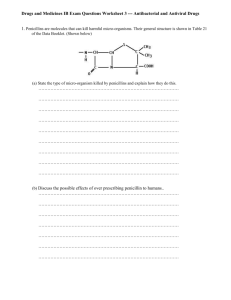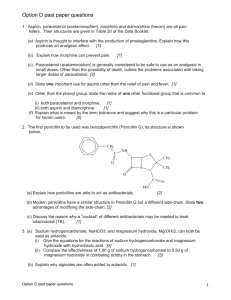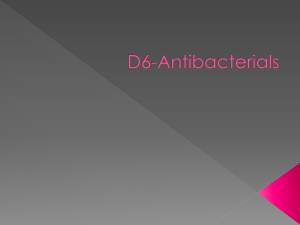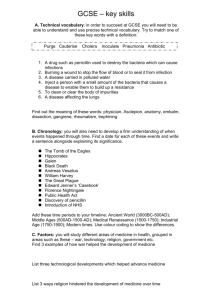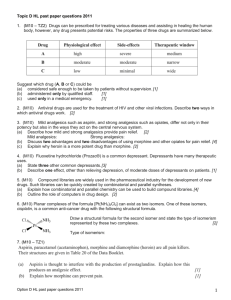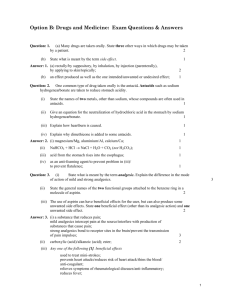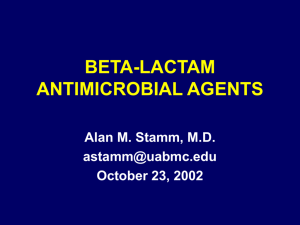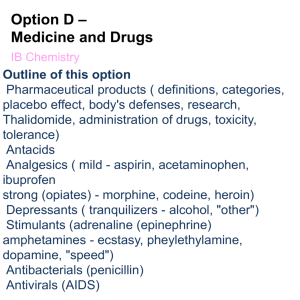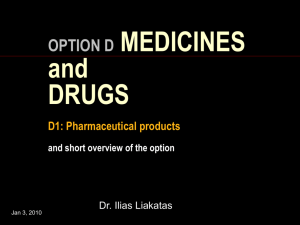Option D. Medicine and Drugs
advertisement
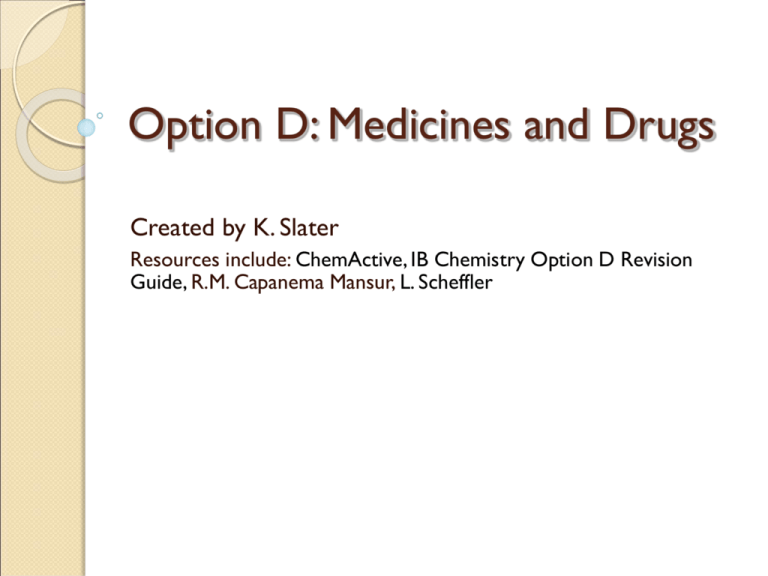
Option D: Medicines and Drugs Created by K. Slater Resources include: ChemActive, IB Chemistry Option D Revision Guide, R.M. Capanema Mansur, L. Scheffler D1 Pharmaceutical products D.1.1 List the effects of medicines and drugs on the functioning of the body. D.1.2 Outline the stages involved in the research, development and testing of new pharmaceutical products. D.1.3 Describe the different methods of administering drugs. D.1.4 Discuss the terms therapeutic window, tolerance and side-effects. D.1.1 List the effects of medicines and drugs on the functioning of the body. Generally, a medicine or drug is any chemical that does one or more of the following: ◦ Alters the physiological state, including consciousness, activity level or coordination ◦ Alters incoming sensory sensations ◦ Alters mood or emotions Sometimes it is difficult to determine whether a drug has any medicinal value D.1.1 List the effects of medicines and drugs on the functioning of the body. Placebo effect: ◦ A pharmacologically inert substance (often a sugar pill) produces a significant reaction because the patient expects, desires, or was told it would happen ◦ Used as a control in clinical trials ◦ Highlights the body’s natural healing powers Questions: D.1.2 Outline the stages involved in the research, development and testing of new pharmaceutical products. Several stages in development of drugs include: ◦ ◦ ◦ ◦ ◦ Isolation or chemical synthesis of the product Laboratory studies Animal testing Clinical testing Approval by the FDA for market D.1.2 Outline the stages involved in the research, development and testing of new pharmaceutical products. Development of a new drug is a very costly, lengthy process controlled by the government: ◦ In 1970, 3620 drugs were tested. 16 came on the market at an average cost of $20 million ◦ Only 1 in 2000 drugs eventually make it to the market ◦ Phase I: Initial clinical trials on volunteers after the drug has proven safe when given to animals ◦ Phase II: Thorough clinical investigation to eliminate investigator bias ◦ Phase III: Extended clinical evaluation D.1.2 Outline the stages involved in the research, development and testing of new pharmaceutical products. All drugs that are approved for market must be clinically tested multiple times: A) Most clinical tests are done on volunteers. B) Neither the researcher know in advance who is receiving the therapeutic medicine and who is receiving a placebo C) Half receives the medicine and the other the placebo The initial trial will establish possible side effects and drug’s safety. D.1.3 Describe the different methods of administering drugs. Drugs must reach blood stream to be transported to critical tissues. The method of administration determines rate at which the drug is absorbed in the blood. Five common points of entry: 1. 2. 3. 4. 5. Oral Inhalation Topical Injection Anal D.1.3 Describe the different methods of administering drugs. Injection methods: ◦ Subcutaneous Under the skin ◦ Intramuscular In the muscle ◦ Intravenous Directly in the vein Questions: D.1.4 Discuss the terms therapeutic window, tolerance and side-effects. Therapeutic window: Relates the therapeutic effects of a drug to its toxic effects Tests are performed on all pharmaceuticals to establish their toxicity ◦ LD50 is the dose (in mg of substance per kg of body mass) that is lethal to to 50% of laboratory animals ◦ LD = Lethal Dose ◦ The lower the LD50, the more toxic the substance Lowest LD50 rating known as of yet: the concentrated form of botulism toxin (BoTox) – most toxic substance known LD50 of roughly 0.005-0.05 µg/kg ◦ http://users.rcn.com/jkimball.ma.ultranet/BiologyPages/L/LD50.html D.1.4 Discuss the terms therapeutic window, tolerance and side-effects. LD50 (g/kg) Aspirin 1.5 Nicotine 0.23 Caffeine 0.13 Botulin 3 x 10-11 Question D.1.4 Discuss the terms therapeutic window, tolerance and side-effects. Tolerance: Over time the body adapts the presence of a drug 1.The person receiving the drug needs ever larger doses to achieve the original effect 2.Tolerance results in increased risks of dependency/addiction 3.Increased risks of toxic levels 4.Possibility of immunity in anti-bacterials D.1.4 Discuss the terms therapeutic window, tolerance and side-effects. Side-effects: Contraindications are additional and often undesirable effects that result from the use of a particular drug to treat a particular condition ◦ Side effects are somewhat relative depending on the reason the drug is prescribed ◦ The prescribing physician must weigh the benefits from the use of a drug against the undesirable side effects when determining a suitable level of risk ◦ The level of risk that is acceptable is related to the severity and the degree to which the condition is life threatening ◦ Examples: chemotherapy, pain killers, etc. Thalidomide: An Example of Improper Drug Approval Developed in Germany in the 1953. Used as a tranquilizer (19571962). Prescribed to combat morning sickness in the early months of pregnancy. Marketed widely in Europe but never approved by the FDA in the USA. Caused major birth defects in ABOUT 10,000 children whose mothers had taken thalidomide. 17 Thalidomide Thalidomide has two optical isomers, one of which is a powerful teratogen. Chiral Carbon 18 Thalidomide Thalidomide is both a tranquilizer and a teratogen It is sometimes used to treat some symptoms of Hansen’s disease. (Leprosy) 19 Review 1. 2. 3. 4. When defining drugs what are three ways in which drugs affect the body? Explain the following: Therapeutic index, tolerance, the placebo effect, effective dose, lethal dose. Outline the steps in bringing a drug to market. What happened with the drug, thalidomide, that resulted in a major drug catastrophe? 20 D2 Antacids D.2.1 State and explain how excess acidity in the stomach can be reduced by the use of different bases. D.2.1 State and explain how excess acidity in the stomach can be reduced by the use of different bases. Food is digested in the stomach that contains gastric juices, HCl with a pH value of about 2. Antacids are compounds that are used to neutralize excess stomach acid(HCl) Most antacids are weak inorganic bases: ◦ ◦ ◦ ◦ ◦ CaCO3 NaHCO3 Mg(OH)2 Al(OH)3 MgO and Mg(OH)2 (Milk of Magnesia) D.2.1 State and explain how excess acidity in the stomach can be reduced by the use of different bases. Neutralization reactions between HCl & … Aluminium hydroxide Magnesium hydroxide Sodium hydrogen carbonate WRITE ‘EM OUT!!! D.2.1 State and explain how excess acidity in the stomach can be reduced by the use of different bases. Question: State and explain which would be more effective as an antacid, 1.0 mol of magnesium hydroxide or 1.0 mol of aluminium hydroxide. Support your answer with balanced equations. (3) Answer: aluminium hydroxide neutralizes more acid / more HCl / moreH+ ions / contains more OH− ions; Al(OH)3 + 3H+ → Al3+ + 3H2O; Mg(OH)2 + 2H+ → Mg2+ + 2H2O; Accept equations with HCl. 3 D.2.1 State and explain how excess acidity in the stomach can be reduced by the use of different bases. Antacids are often combined with alginates and antifoaming agents Aliginates float on the stomach contents to form a neutralizing layer preventing heart burn Antifoaming agents such as dimethicone prevent the formation of gases and reduce flatulence D3 Analgesics D.3.1 Describe and explain the different ways that analgesics prevent pain. D.3.2 Describe the use of derivatives of salicylic acid as mild analgesics, and compare the advantages and disadvantages of using aspirin and paracetamol (acetaminophen). D.3.3 Compare the structures of morphine, codeine and diamorphine (heroin, a semisynthetic opiate). D.3.4 Discuss the advantages and disadvantages of using morphine and its derivatives as strong analgesics. D.3.1 Describe and explain the different ways that analgesics prevent pain. Analgesics: substances that reduce pain without the aid of sleep Mild: Intercept the pain stimulus at the source of injury or interfere with production of substances (like prostaglandins) that cause pain, swelling or fever. ◦ Aspirin and Paracetamol Strong: Temporarily bond with receptor sites in the brain, preventing the transmission of pain impulses without depressing the CNS. ◦ Morphine D.3.1 Describe and explain the different ways that analgesics prevent pain. – Aspirin Salicylic acid was in wide use as a pain killer and antipyretic but it irritates & damages the mouth, esophagus and stomach membranes 2 hydroxybenzoic acid In 1899, Bayer introduced the ethanoate ester of salicylic acid: 2 acetoxybenzoic acid or acetyl salicylic acid D.3.1 Describe and explain the different ways that analgesics prevent pain. – Paracetamol (acetaminophen) Less side effects than aspirin. May cause kidney, liver damage Functional group: amide Preferred in the USA Overdose can cause brain damage to liver and kidneys D.3.1 Describe and explain the different ways that analgesics prevent pain. – Opiates Strong analgesics are given to relieve severe pain caused by injury, surgery, heart attack or chronic diseases. Opiates go straight to the brain, find chemical receptors that receive pain messages and bind with (and blocking) the receptors, which stops the transmission of pain Problems: Tolerance can develop OD death D.3.2 Describe the use of derivatives of salicylic acid as mild analgesics, and compare the advantages and disadvantages of using aspirin and paracetamol (acetaminophen). Aspirin Pros: ◦ Preventing recurrence of heart attacks & strokes (prevents blood clotting) Cons: ◦ Ulceration & stomach bleeding ◦ Allergic reactions ◦ Reye’s syndrome in children – a potentially fatal liver and brain disorder ◦ Overdose can lead to acidosis (low blood pH) D.3.2 Describe the use of derivatives of salicylic acid as mild analgesics, and compare the advantages and disadvantages of using aspirin and paracetamol (acetaminophen). Paracetamol (acetaminophen) Pros: ◦ Very safe in the correct dose ◦ Safe for children – no side effects Cons: ◦ In rare cases, can cause blood disorders and kidney damage ◦ OD can lead to serious liver damage, brain damage and even death D.3.3 Compare the structures of morphine, codeine and diamorphine (heroin, a semi-synthetic opiate). Morphine, codeine (found in opium poppy) and heroin all have same basic structure: Structure of morphine D.3.3 Compare the structures of morphine, codeine and diamorphine (heroin, a semi-synthetic opiate). D.3.3 Compare the structures of morphine, codeine and diamorphine (heroin, a semi-synthetic opiate). Morphine has an alcohol (hydroxyl group) In codeine, the hydroxyl group is replaced by a methyl group. Heroin has 2 acetyl groups (ethanoate) D.3.4 Discuss the advantages and disadvantages of using morphine and its derivatives as strong analgesics. Advantages: ◦ Extremely strong, relieve severe pain caused by injury, surgery, heart attack or chronic diseases ◦ Treatment of diarrhea (produces constipation) ◦ Cough suppressant D.3.4 Discuss the advantages and disadvantages of using morphine and its derivatives as strong analgesics. Disadvantages – short-term: ◦ ◦ ◦ ◦ Euphoria Depress nervous system (slow breathing) Nausea & vomiting May lead to coma / death Disadvantages – long-term: ◦ Constipation, poor eating habits ◦ Increased tolerance addiction Social problems, such as theft & prostitution Risk of AIDS, hepatitis, etc. from sharing needles Cross-tolerance: increases tolerance for other opiates D4 Depressants D.4.1 Describe the effects of depressants. D.4.2 Discuss the social and physiological effects of the use and abuse of ethanol. D.4.3 Describe and explain the techniques used for the detection of ethanol in the breath, the blood and urine. D.4.4 Describe the synergistic effects of ethanol with other drugs. D.4.5 Identify other commonly used depressants and describe their structures. D.4.1 Describe the effects of depressants. Depressants: a group of drugs that, according to dosage, reduce anxiety, produce calm and induce sleep ◦ Often described as antidepressants b/c they relieve depression ◦ Examples: alcohol, barbituates (phenobarbital) and benodiazepines Low doses: may exert little or no effect Moderate doses: may induce sedation (soothing, reduction of anxiety) High doses: may induce sleep Extremely high doses: may cause death D.4.2 Discuss the social and physiological effects of the use and abuse of ethanol. Physiological Effects Social and Economic Consequences Reduction in inhibitions Violent behaviour (like the British spelling? ) to family or strangers Increase in car accidents Short-term reduction in reaction speed Short-term hangover Absenteeism from work Long-term liver (and much other) damage Cost of intensive medical care D.4.2 Discuss the social and physiological effects of the use and abuse of ethanol. Short-term health effects (Effect depends on body mass and concentration of alcohol in the blood) Reduces anxiety and inhibitions Increases confidence & sociability Dilates small blood vessels warmth Impairs attention, judgment, and control Violent or aggressive behavior Loss of motor function Long-term health effects Alcoholism is caused by an inability to reduce alcohol intake ◦ Withdrawal symptoms: nausea, sweating, anxiety, hypertension or delirium tremens (shaking) ◦ Tolerance Cirrhosis (scarring) and cancer of the liver (the major detoxification organ) Heart disease Hypertension Strokes Gastritis Ulcers Depression Miscarriage / birth defects D.4.3 Describe and explain the techniques used for the detection of ethanol in the breath, the blood and urine. Multiple methods are used to detect alcohol levels 1. 2. 3. Breathalyser by potassium dichromate (VI) Blood or urine analysis by chromatography Absorption of infrared radiation or fuel cell in an intoximeter D.4.3 Describe and explain the techniques used for the detection of ethanol in the breath, the blood and urine. 1. Breathalyser by potassium dichromate (VI) Subject breathes into an analyzer containing an oxidizing agent and a detector Potassium dichromate (K2CrO4) is the oxidizing agent Oxidizes ethanol to ethanoic acid This is an oxidation-reduction reaction that involves an electron transfer Cr+6 (orange) is reduced into Cr+3 (green) --- KNOW THIS This electron transfer generates an electric current which can be detected by the machine D.4.3 Describe and explain the techniques used for the detection of ethanol in the breath, the blood and urine. 2. Blood or urine analysis by chromatography More precise than breathalyzer Uses a stationary phase (non-volatile liquid or solid support) and a mobile phase (inert gas, like N2) Breath components (CO2, H2O, and alcohol vapor) are injected into the machine and partitioned (divided) between the stationary and mobile phases Components exit at different intervals (each substance has a different affinity and bond strength for the two phases, and thus move through at different rates) Components are detected Retention time for each component is measured (time taken for each component to pass through the column) Blood alcohol’s retention time is compared to the retention time for a standard ethanol sample D.4.3 Describe and explain the techniques used for the detection of ethanol in the breath, the blood and urine. 3. Absorption of infrared radiation or fuel cell in the intoximeter IR light does not promote electrons to higher levels, but does provide enough energy to make molecules “vibrate” ◦ Vibrational motion depends on the mass of the molecule and the types of bonds present IR spectrum therefore depends on types of molecules present (“molecular fingerprint”) Scale is based on wavenumber (1/wavelength) Police use intoximeter (IR spectrometer) to confirm breathalyzer test ◦ ◦ ◦ IR radiation is passed through breath sample C-H group in alcohol absorbs a certain frequency of IR light % transmittance of the C-H frequency is determined, indicating amount of alcohol present D.4.3 Describe and explain the techniques used for the detection of ethanol in the breath, the blood and urine. Question: A modern method for accurately determining the amount of alcohol in breath uses an intoximeter. Explain how an intoximeter works. (3) Answer: sample of breath passed into infrared spectrometer; ethanol in breath absorbs because of OH group; machine compares breath with air/reference sample with no breath D.4.4 Describe the synergistic effects of ethanol with other drugs. Synergistic effect: the combination of the two drugs may be more harmful than either drug alone When alcohol interacts with other drugs: ◦ Can produce coma or death when combined with sleeping pills or barbiturates ◦ Can cause stomach bleeding with aspirin ◦ Can extend and enhance the “high” when mixed with cocaine Also causes severe vasoconstriction (narrowing of blood vessels leading to a rise in blood pressure) and cardiac arrhythmia (irregular heart beat) ◦ Can inhibit breakdown of other drugs D.4.5 Identify other commonly used depressants and describe their structures. Diazepam (Valium): relieves anxiety and tension, muscle relaxer Nitrazepam (Mogadon): hypnotic drug used to induce sleep Fluoxetine hydrochloride (Prozac): used to treat mental depression by increasing serotonin activity (a neurotransmitter) D.4.5 Identify other commonly used depressants and describe their structures. Fluoxetine hydrochloride (Prozac) Questions: Questions: D5 Stimulants D.5.1 List the physiological effects of stimulants. D.5.2 Compare amphetamines and epinephrine (adrenaline). D.5.3 Discuss the short- and long-term effects of nicotine consumption. D.5.4 Describe the effects of caffeine and compare its structure with that of nicotine. D.5.1 List the physiological effects of stimulants. Stimulants: Molecules that increase alertness and give greater sensitivity to external stimuli ◦ Mental processes may speed up ◦ May create feelings of elation or possibly anxiety D.5.2 Compare amphetamines and epinephrine (adrenaline). Adrenaline is a naturally occurring hormone and stimulant – fight or flight Amphetamines mimic the effects of epinephrine (adrenaline) and are known as sympathomimetic drugs D.5.2 Compare amphetamines and epinephrine (adrenaline). Amphetamines and epinephrine (adrenaline) are chemically similar in that both derive from the phenylethylamine structure (i.e. a benzene ring with a 2-C chain and an amine group at the end) D.5.2 Compare amphetamines and epinephrine (adrenaline). ◦ Amphetamine is a primary amine, having a –NH2 group D.5.3 Discuss the short- and long-term effects of nicotine consumption. Short-term: ◦ ◦ ◦ ◦ ◦ Increased heart rate Increased blood pressure Reduction in urine output Decrease in reflex times Stimulating effects Long-term: ◦ Increased risk of heart disease ◦ Coronary thrombosis ◦ Peptic ulcers D.5.3 Discuss the short- and long-term effects of nicotine consumption. Addictive properties of nicotine Further risks associated with smoking tobacco, such as lung cancer D.5.4 Describe the effects of caffeine and compare its structure with that of nicotine. Caffeine is a respiratory stimulant ◦ When consumed in large amounts it can cause anxiety, irritability and sleeplessness ◦ It is a weak diuretic (promotes the formation of urine) D.5.4 Describe the effects of caffeine and compare its structure with that of nicotine. Both caffeine and nicotine contain a tertiary amine group (a nitrogen atom bonded to three carbons) D.4.3 Describe and explain the techniques used for the detection of ethanol in the breath, the blood and urine. Question: Describe two similarities in their structures, not including the presence of double bonds, methyl groups and nitrogen atoms. Answer: both contain six-membered ring; five-membered ring; (tertiary) amine group; N- has methyl group attached; 2 max ◦ Award [1] each for any two. Methylamphetamine (also known as methamphetamine or “speed”) and caffeine are stimulants with the following structures. (a) (i) On the structure for methylamphetamine above, draw a ring around the amine group. (1) (ii)Determine whether both amine groups in caffeine are primary, secondary or tertiary. (1) (b) Caffeine contains the group . State the general name for this functional group. (1) (Total 3 marks) (a) (i) ◦ The ring must circle the N atom to gain the mark. ◦ (ii) tertiary (b) amide / N-methylamide (accept peptide) D6 Antibacterials D.6.1 Outline the historical development of penicillins. D.6.2 Explain how penicillins work and discuss the effects of modifying the sidechain. D.6.3 Discuss and explain the importance of patient compliance and the effect of penicillin overprescription. D.6.1 Outline the historical development of penicillins. Antibacterial: a destructive to or inhibiting the growth of bacteria Penicillin: any of several antibiotics of low toxicity, produced naturally by molds of Penicillium D.6.1 Outline the historical development of penicillins. Alexander Fleming – a name to know A bacteriologist, studied an antibacterial agent present in tears and nasal mucus, as well as in egg whites (called lysozyme) – in the 1920s Left a pile of used culture plates containing a growth of a Staphylococcus bacterium A rare stain of fungus called Penicillium notate entered through a window and landed on one of the plates A month later the fungus multiplied and inhibited the growth of the surrounding Staphylococcus bacteria Ultimately, Fleming found that Penicillium produces “penicillin” when its food resources are limited & that it inhibits the growth of a wide range of bacteria D.6.1 Outline the historical development of penicillins. Howard Florey – another name to know Ernst Chain – aaaand yet another name to know Florey continued research on lysozyme (the antibacterial agent in egg whites) – in the 1920s & 1930s Chain (Florey’s student) showed that lysozyme attcks the cell walls of bacteria disintegration – 1937 Chain (& 2 other scientists) improved the method of isolating penicillin, improving its purity – 1938 Chain was known for producing large quantities of penicillin and conducting medical trials In 1945, Fleming, Florey & Chain were jointly awarded the Nobel Prize in Physiology or Medicine D.6.2 Explain how penicillins work and discuss the effects of modifying the side-chain. Penicillins work by interfering with the chemicals that bacteria need to form normal cell walls Modifying the side-chain results in penicillins that are more resistent to the penicillinase enzyme Penicillins differ only in their type of side chain ◦ Penicillins function by interfering with the cross-links that connect separate layers of the bacterial cell wall Cell wall is weakened and the bacterial cell bursts, killing the bacteria Humans do not have cell walls and are thus unaffected by penicillins Mode of Action of Penicillin They work by interfering with the enzymes that bacteria need to make normal cell walls. These enzymes can become resistant. As the cell swells, the osmotic pressure causes the wall to disintegrate. Benzylpenicillin D.6.2 Explain how penicillins work and discuss the effects of modifying the side-chain. The origin penicillin notation mold was found to produce a mixture of different penicillin's that are called G, X, F and K. The most useful is Penicillin G because it has a high effectiveness and a higher yield from the fermentation process. Attempts have been made to modify the natural penicillins chemically to vary the R group 3 new Penicillin's were created: S, O, and V D.6.3 Discuss and explain the importance of patient compliance and the effect of penicillin overprescription. Penicillin quickly became widely used as antibiotic against a variety of bacteria Some history: ◦ During World War II, penicillins helped to rid of infected wounds (the biggest wartime killer) ◦ Also used to treat infected transmitted infections (STI’s) that were common in soldiers D.6.3 Discuss and explain the importance of patient compliance and the effect of penicillin overprescription. Drug companies began mass producing penicillin in 1943 Penicillin-resistant bacteria Bacteria can become resistant to penicillin (and other antibiotics) because of overprescription Problem: If people take penicillin for a minor bacterial infection than their immune system would be able to deal with it, they are increasing the chances of resistant strain emerging D.6.3 Discuss and explain the importance of patient compliance and the effect of penicillin overprescription. When the non-resistant bacteria are destroyed, the small numbers of resistant forms will be able to multiply due to an absence of competition A process of natural selection that occurred in the bacterial population Similar reasoning can also be applied to people who do need to take antibiotics, but do not complete their course of treatment D.6.3 Discuss and explain the importance of patient compliance and the effect of penicillin overprescription. Example: Tuberculosis (TB) Treatment ◦ This takes 6-12 months of antibiotics to rid of the bacteria ◦ TB resistance to penicillin and antibiotics is growing since the process takes so long ◦ This could be considered an overprescription ◦ It gives time for bacteria to build up resistance D.6.3 Discuss and explain the importance of patient compliance and the effect of penicillin overprescription. Antibiotics have been widely used in the livestock industry to treat sick animals and to promote growth Other drugs prescribed to livestock include hormones to fatten and build up bulk weight and to reduce stress D7 Antivirals D.7.1 State how viruses differ from bacteria. D.7.2 Describe the different ways in which antiviral drugs work. D.7.3 Discuss the difficulties associated with solving the AIDS problem. D.7.1 State how viruses differ from bacteria. Bacteria Viruses Individual cell (has the machinery to do all it needs to survive itself) Acellular (don’t have organelles & can’t survive without a host) Reproduces on its own Requires a living host to reproduce Circular DNA DNA or RNA in a capsid Use & obtain energy / metabolize on their own Uses & obtains energy / from its host Bigger Smaller Grows & develops on its own Cannot grow or develop Viruses How big is it? http://www.cellsalive.com/howbig.htm How viruses invade… http://www.youtube.com/watch?v=Rpj0emEGShQ Various Viruses How Viruses Invade D.7.2 Describe the different ways in which antiviral drugs work. Antiviral drugs may work by: ◦ altering the cell’s genetic material so the virus cannot use it to multiply ◦ OR preventing the viruses from multiplying by blocking enzyme activity within the host cell D.7.2 Describe the different ways in which antiviral drugs work. Three possible approaches to killing a virus: 1. The Trojan Horse 2. Retrovirus Inhibitors 3. Blunting the scissors D.7.2 Describe the different ways in which antiviral drugs work. 1. The Trojan Horse Viruses uses host’s DNA-polymerase to replicate viral DNA Some antiviral drugs are structurally similar to viral DNA and codes for the replication process to stop This is a challenge because the drug has to be “activated” by a viral enzyme D.7.2 Describe the different ways in which antiviral drugs work. 2. Retrovirus Inhibitors A retrovirus (such as AIDS) contains RNA rather than DNA Normally, when retroviruses inject their RNA into host cells, they use an enzyme, reversetranscriptase, to convert their RNA into viral DNA in the cell Retrovirus inhibitors work by inhibiting the reverse-transcriptase enzyme and preventing the formation of viral DNA Example: AZT (Azidothymadine) is the best known anti-AIDS drug D.7.2 Describe the different ways in which antiviral drugs work. 3. Blunting the scissors When new baby viruses are created in their host cells, they need to escape so they can infect other cells They are able to do this by using an enzyme (neuraminidase) which cuts open the host cell wall, sort of like a pair of scissors If we introduce an inhibitor molecule (making it so they can’t make those cuts), then the viruses permanently stay inside of the cell, rendering itself harmless (since it can’t replicate) D.7.3 Discuss the difficulties associated with solving the AIDS problem. Specific proteins on the HIV virus bind to a receptor protein on white blood cells called T cells Effective treatment with antiviral drugs is difficult (as is vaccine development) since: ◦ ◦ ◦ ◦ Viruses are simple & replicate quickly Viruses can mutate quickly & “learn” to cope with the drugs Viral metabolism is linked closely with the host cell Killing the virus could actually be easy if you didn’t care about making sure the host lives :/ Therefore, pharmaceutical chemists focus on the selective toxicity that allows the drug to work AZT (Azidothymadine) is the best known antiHIV/AIDS drug D.7.3 Discuss the difficulties associated with solving the AIDS problem. Other factors ◦ ◦ Cost: it’s expensive Societal & cultural: 95% of HIV positive people live in developing countries Less than 8% who need retroviral therapy actually receive it AIDS stigma… leads to a fear of discrimination and/or violence, which can prevent many people from getting tested or Thus, prevention becomes a key aim in trying to prevent the spread of / controlling AIDS
